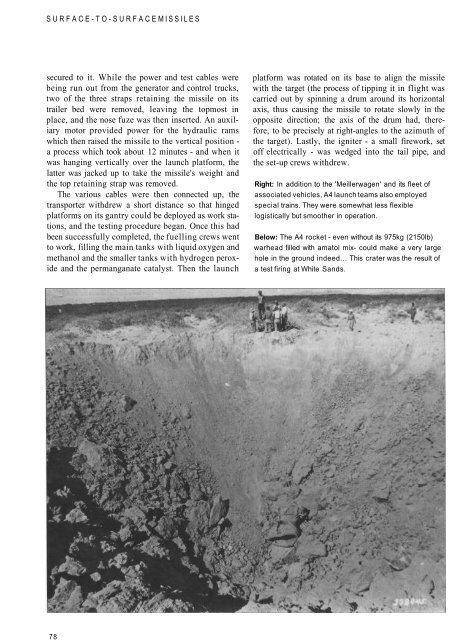Submarines and their Weapons - Aircraft of World War II
Submarines and their Weapons - Aircraft of World War II
Submarines and their Weapons - Aircraft of World War II
Create successful ePaper yourself
Turn your PDF publications into a flip-book with our unique Google optimized e-Paper software.
SURFACE-TO-SURFACE MISSILES<br />
secured to it. While the power <strong>and</strong> test cables were<br />
being run out from the generator <strong>and</strong> control trucks,<br />
two <strong>of</strong> the three straps retaining the missile on its<br />
trailer bed were removed, leaving the topmost in<br />
place, <strong>and</strong> the nose fuze was then inserted. An auxiliary<br />
motor provided power for the hydraulic rams<br />
which then raised the missile to the vertical position -<br />
a process which took about 12 minutes - <strong>and</strong> when it<br />
was hanging vertically over the launch platform, the<br />
latter was jacked up to take the missile's weight <strong>and</strong><br />
the top retaining strap was removed.<br />
The various cables were then connected up, the<br />
transporter withdrew a short distance so that hinged<br />
platforms on its gantry could be deployed as work stations,<br />
<strong>and</strong> the testing procedure began. Once this had<br />
been successfully completed, the fuelling crews went<br />
to work, filling the main tanks with liquid oxygen <strong>and</strong><br />
methanol <strong>and</strong> the smaller tanks with hydrogen peroxide<br />
<strong>and</strong> the permanganate catalyst. Then the launch<br />
78<br />
platform was rotated on its base to align the missile<br />
with the target (the process <strong>of</strong> tipping it in flight was<br />
carried out by spinning a drum around its horizontal<br />
axis, thus causing the missile to rotate slowly in the<br />
opposite direction; the axis <strong>of</strong> the drum had, therefore,<br />
to be precisely at right-angles to the azimuth <strong>of</strong><br />
the target). Lastly, the igniter - a small firework, set<br />
<strong>of</strong>f electrically - was wedged into the tail pipe, <strong>and</strong><br />
the set-up crews withdrew.<br />
Right: In addition to the 'Meillerwagen' <strong>and</strong> its fleet <strong>of</strong><br />
associated vehicles, A4 launch teams also employed<br />
special trains. They were somewhat less flexible<br />
logistically but smoother in operation.<br />
Below: The A4 rocket - even without its 975kg (2150lb)<br />
warhead filled with amatol mix- could make a very large<br />
hole in the ground indeed... This crater was the result <strong>of</strong><br />
a test firing at White S<strong>and</strong>s.


